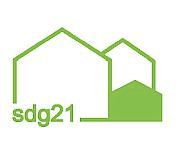- Gartenstadt21 is characterised by joint organisational and financing models which ensure its development and long-term maintenance.
- Gartenstadt21 enables adaptable and sustainable models of general participation to be developed and made permanent.
- Gartenstadt21 brings about a qualification and networking of existing settlement and open space structures in the metropolitan region.
- The Gartenstadt21 has urban qualities in which a high building density and public open spaces are in an appropriate relationship to each other.
- Gartenstadt21 offers an attractive "green infrastructure", in the sense of differentiated public open spaces with various functions
- The Gartenstadt21 is climate-adapted and energy-optimised
- Gartenstadt21 offers a variety of affordable housing options for different social groups
- The Gartenstadt21 takes into account new forms of working and the principles of the circular economy in equal measure.
- Gartenstadt21 has various public and social facilities for people of different ages and backgrounds
- Gartenstadt21 is characterised by a networked mobility offer and thus contributes to a reduction in traffic congestion.
As part of the BBSR study, 10 theses were developed for a "Garden City21 green-urban-networked" that describe process-related and functional qualities of sustainable and integrated urban development. These theses formed the basis for the in-depth investigation within the framework of the Future Lab.
>> more information about the future lab
Source:
www.bbsr.bund.de/...Gartenstadt-21/03-ergebnisse.html...
Keywords: Greening / climate adaptation, New books and studies, Quarters, Settlements

